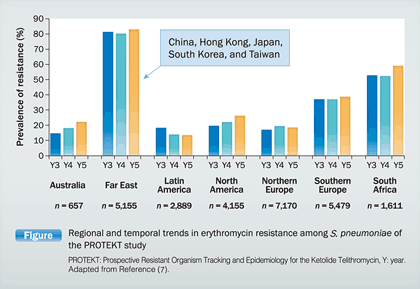Levofloxacin: a Mainstay of Fluoroquinolone-Based Therapy-After Twenty Years of Use, Levofloxacin Remains Safe and Effective
A Microbiological Approach for Managing Community-Acquired Pneumonia: Levofloxacin Remains Active against Major Pathogens Including Those Resistant to Other Antimicrobials


The choice of antimicrobial treatment for community-acquired pneumonia (CAP) depends on the likely causative pathogens and patients involved. With this in mind, Prof. Cantón provided a clear update of the trends in bacterial etiology and resistance, and how this is impacting on optimal treatment. He noted that while antimicrobial resistance among Streptococcus pneumoniae, Haemophilus influenzae, and Pseudomonas aeruginosa is well documented, it is also now clear that macrolide resistance is growing among Mycoplasma pneumoniae. This is particularly a problem in China, where 90% of M. pneumoniae isolates are now macrolide resistant.
When prescribing an antimicrobial, it is important to consider regional resistance trends as well as patient characteristics, with those with no prior risk factors having a lower incidence of resistant pathogens compared with those in hospitals or intensive care units (ICUs) (1). In addition, improvement in diagnostic tools for identifying causative pathogens has identified a greater incidence of mixed infections, emphasizing the need for broad coverage (2). This is supported by results using new molecular tools and metagenomic approaches, demonstrating an increase in polymicrobial CAP infections, and identifying microorganisms not previously associated with CAP (3). Therefore, fluoroquinolones, particularly respiratory agents like levofloxacin, are beneficial in this setting, as they possess broad-spectrum activity to combat mixed infections.
Running in tandem with the need to identify pathogens responsible for causing CAP, is the need to monitor resistance patterns. State-of-the-art resistance data reported by Prof. Cantón found that while rates of penicillin-resistant S. pneumoniae (PRSP) may be stable or decreasing in some areas of previously high resistance, there remain wide regional variations. Macrolide-resistant S. pneumoniae (MRSP) also remains a problem, although some surveillance studies have shown this to be decreasing. However, Prof. Cantón said that this again is very dependent on the region, and results from a recent Spanish study show that the decrease is not statistically significant (4). Prof. Cantón also noted that dispersion of MRSP isolates with dual resistance mechanisms is of clinical concern. In contrast, resistance to levofloxacin remains low, and it continues to be recommended for treating PRSP infections (5).
In regard to H. influenzae, Prof. Cantón noted that the emergence of H. influenzae isolates with penicillin-binding protein mutations is of concern to clinicians, as these isolates have been associated with non-β-lactamase-mediated ampicillin resistance as well as amoxicillin-clavulanate resistance. In addition, azithromycin-resistant H. influenzae strains have now been reported due to ribosomal mutations, which impart intrinsic resistance to other macrolides. Again, in sharp contrast to this, only a few H. influenzae isolates are resistant to fluoroquinolones, and levofloxacin has been recommended for use against these pathogens (5).
M. pneumoniae is intrinsically resistant to β-lactams. However, strains with acquired resistance to macrolides have emerged and have been spreading in Europe, the US, and Asia in particular with more than 90% of Chinese isolates resistant to erythromycin and azithromycin (6). In contrast, M. pneumoniae shows no resistance to fluoroquinolones in vivo.
Increasing resistance in China is also occurring with S. pneumoniaewith high penicillin and erythromycin resistance rates (nearly from 80% to 90% of Chinese S. pneumoniae isolates are now resistant to macrolides, with dispersion of isolates not only with the erm(B), but also with mef(A) and dual mechanisms) (Figure) (7). Surveillance programs have demonstrated a low prevalence of fluoroquinolone-resistant strains in S. pneumoniae and they remain active against PRSP despite the frequent use of fluoroquinolones (8).
 |
| Click on image to enlarge. |
In order to provide optimal treatment of these resistant CAP pathogens, a number of professional societies have published guidelines for the management of respiratory infections. These include those published in 2007 by the Infectious Diseases Society of America (IDSA)/American Thoracic Society (ATS) (9), and the latest report from the Joint Task Force of the European Respiratory Society and European Society of Clinical Microbiology and Infectious Diseases published in 2011 (1). These guidelines provide evidence-based recommendations for adult CAP and recommend levofloxacin as treatment for patients with both community-based care and those requiring hospitalization or ICU admission. In terms of treating specific pathogens, they list levofloxacin as useful for treating highly resistant S. pneumoniae, methicillin-susceptible Staphylococcus aureus (MSSA), ampicillin-resistant H. influenzae, M. pneumoniae, Chlamydophila pneumoniae, Legionella spp. and Coxiella burnetii.
Prof. Cantón concluded that the broad-spectrum and continuing activity of levofloxacin, with efficacy against many pathogens which are resistant to other antimicrobials, makes it an important agent for the treatment of CAP.
References
(1) Woodhead M, et al. Clin Microbiol Infect 2011; 17 Suppl 6: E1-59.
(2) Johansson N, et al. Clin Infect Dis 2010; 50: 202-9.
(3) Bousbia S, et al. PLoS One 2012; 7: e32486.
(4) Pérez-Trallero E, et al. Antimicrob Agents Chemother 2010; 54: 2953-9.
(5) Woodhead M, et al. Clin Microbiol Infect 2011; 17 Suppl 6: 1-24.
(6) Bébéar C, et al. Future Microbiol 2011; 6: 423-31.
(7) Felmingham D, et al. J Infect 2007; 55: 111-8.
(8) Pletz MW, et al. Int J Med Microbiol 2011; 301: 53-7.
(9) Mandell LA, et al. Clin Infect Dis 2007; 44 Suppl 2: S27-72.









